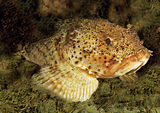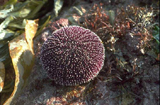 |
|
Weever fish, rockfish and stingrays
Weever fish are responsible for most envenomation in mainland France! Very often present in the waters along the coastline of mainland France, weever fish spend most of their time buried just under the sand, with their venomous stingers and backfin just showing. The French coastline is home to two species of weever fish (large weever fish and small weever fish). |
|
 |
Rockfish, also referred to as scorpion fish in the tropics, are found most often in the sand or near rocks, even where the water is shallow. It has stingers on its head and fins. The most dangerous specimens are found in the tropical waters of the Indian-Pacific Ocean, in particular near coral reefs. Rockfish wounds by species found mainly in the warm waters of the Indian-Pacific Ocean and Reunion Island can be fatal! |
|
Lastly, some stingrays have a venomous lancet at the tip of their tail. The fish are usually found in the sand bottom. The common stingray is responsible for most stingray envenomation, in particular in the Caribbean Sea.
Bathers are generally injured when walking or accidentally putting their hand on the fish. |
|
Signs of envenomation and recommended action:
The clinical picture of a sting victim, in all of the aforementioned cases, is the same: often very acute pain and swelling in the affected body part, which may become slightly livid or purplish and bleed lightly. More severe reactions can be seen, with anxiety, shaking, respiratory or digestive disorders and even nightmares if the sting is not treated. When this occurs, it is recommended that heat be applied as closely and quickly as possible to the sting, in order to destroy the venom. Then, the wound needs to be disinfected. If the pain persists, ask for a doctor’s advice, as it may be necessary to remove a fragment of the stinger.
The most serious stings are often those of tropical species, especially the rockfish. It is not uncommon to see the entire lower body paralysed and respiratory or cardiac arrest ensue. In the event of rockfish envenomation, the accident victim must be taken to the hospital as quickly as possible.
Stingray envenomation is rare in mainland France, but more frequent in the Caribbean or Indian Ocean. Their sting can be very painful and cause hot flashes, anxiety and numbing. Serious envenomation can cause low blood pressure, convulsions and respiratory distress… Stingray victims should receive the same emergency care as weever fish and rockfish victims.
Cones
 |
Considered the most beautiful shellfish in the world by collectors, cones can be the cause of sometimes-fatal and always daunting envenomation. While not all of their stings are deadly to man, many cones are venomous. Cones are most often found in shallow coral reef waters in the Indian Pacific Ocean, but can also be found in the tropical regions of the Atlantic Ocean. Several accidents have been reported in French Polynesia, New Caledonia and Reunion Island. |
Signs of envenomation and recommended action
Envenomation occurs when the living shellfish is picked up. The pain is felt sharply and immediately and is accompanied by major swelling, local paralysis and dizziness. In addition, the victim’s vision, speech and awareness may be impaired. Cardio-respiratory paralysis leading to death is not uncommon and can occur one hour after the sting.
As with envenomation caused by sea snakes, the appropriate emergency response is to disinfect the wound, apply moderate pressure to the affected limb and take the victim to the hospital for emergency care.
Urchins
The urchins dwelling along the French coastline are not venomous, but their stingers can pierce the skin, break off, and cause very severe pain. When this occurs, the wound needs to be disinfected and the stinger debris removed carefully, using thick adhesive tape, for instance. Call a doctor if necessary. |
 |
|
 |